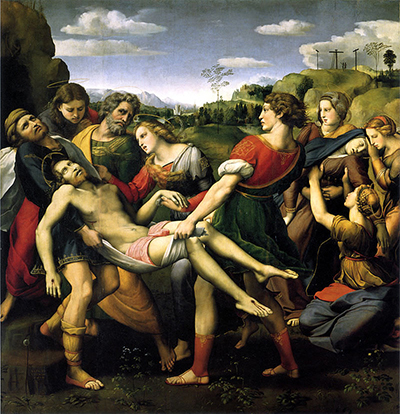The Entombment by Raphael is an oil painting signed Raphael Urbinas MDVII and dated 1507. The picture is an art gallery located in Rome called Galleria Borghese.
It's the central panel of the larger altarpiece that Atalanta Baglioni of Perugia commissioned in honour of Grifonetto Baglioni, her slain son. Like many works, the painting shares elements of the well-known subjects of the Lamentation of Christ, the Entombment of Christ and the Deposition of Christ. The painting measures 184 by 176 cm, and it's on a wood panel. The famous Italian artists' biographer, Giorgio Vasari, understood the piece by Raphael as a narrative painting. Vasari described the picture stating that in most divine painting, there's a Dead Christ being carried to the Sepulcher. It was executed with such loving care and freshness, that it appears to the eye of the viewer to have just been painted.
In this work's composition, Raphael was imagining the sadness that the closest and most affectionate relatives of a person who has died feel when laying their body to rest, and they were their best beloved. The happiness, honour, as well as the entire family's welfare, have depended on the deceased. Our Lady is in a swoon; the heads of the figures are gracious in their weeping, especially Saint John, who bows his head with his hands clasped, in such a way as to move the toughest heart in pity. In truth, whoever notes the grace, art and diligence shown by this painting, has an excellent reason to marvel. The picture amazes everyone that views it: from the beauty of the clothes to the supreme perfection that it shows in every part.
On the far right of the painting, in the other figurative group who are slightly behind the action, there are 3 Marys who are supporting Virgin Mary after fainting. This is a controversial depiction called Lo Spasimo della Vergine (Swoon of the Virgin) because of her overwhelming grief. Also, the way Virgin Mary is kneeling is awkward, with excessive torsion plus sharply cut drapery (figura serpentinata). Although it has been seen in other popular works, the Virgin's positioning appears to have been inspired directly by Michelangelo's Doni Tondo example, which was finished a few years earlier. Regarding colour, Raphael managed to balance his use of strong greens, yellows, blues and reds and creates subtle contrast in the flesh tones, which is best seen with Mary Magdalene's holding of the hand of the dead Christ.
Vasari took a reverential tone when describing the painting. He took great care discussing important figures in the picture and their effect on the viewer. When looking at it in a formal manner, the scene depicted is neither the Entombment nor the Deposition but positioned somewhere in-between. This can be determined by the background: Mount Calvary is on the right, this is the location of the Deposition and Crucifixion, while on the left side is the cave, the place where Entombment will occur. The legs of Nicodemus and St. John present a distracting problem, particularly in Nicodemus case. The reason is due to the view obstruction, it's not clear what he's doing or looking at.




